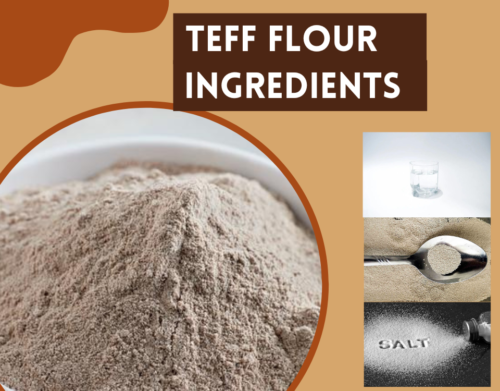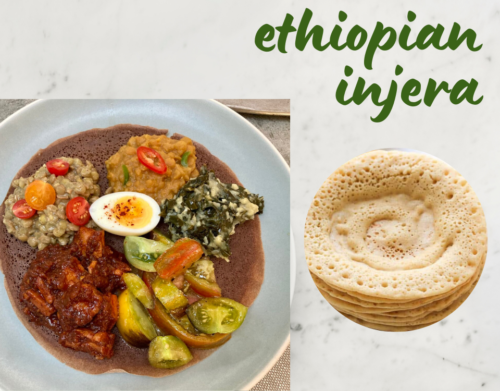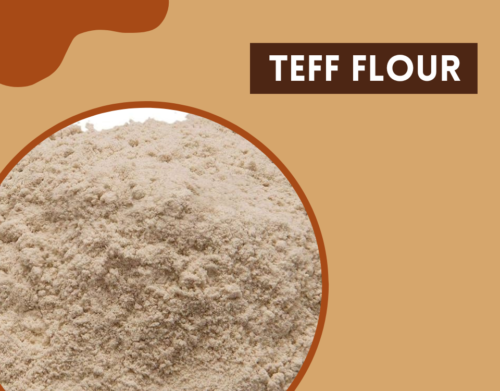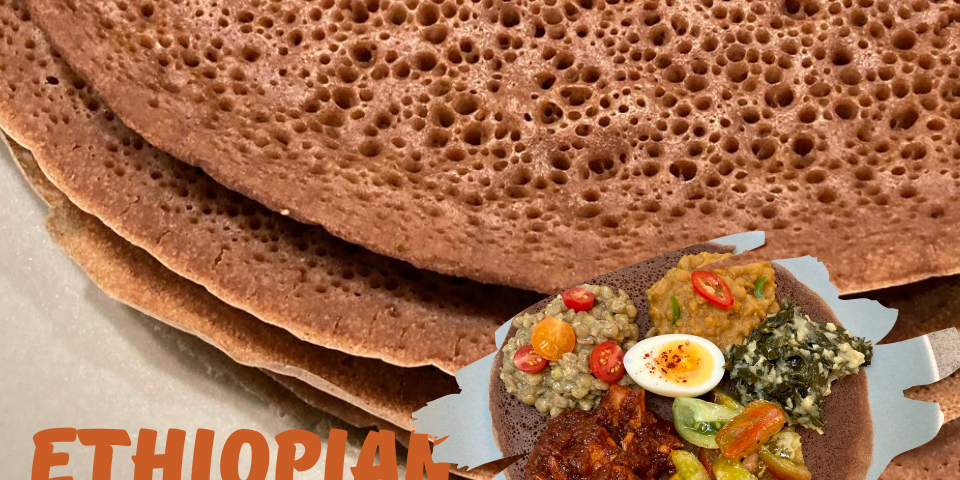
Best fruit juice in usa for health
January 12, 2024Breakfast
January 18, 2024Mastering the Art: Step-by-Step Traditional Ethiopian Injera Recipe
Introduction:
Traditional Ethiopian Injera Recipe. Injera is a sour, fermented flatbread made from teff flour, water, and yeast. it is a national dish of Ethiopia and Eritrea, Its distinct spongy texture and slightly sour taste make it a popular base for stews, veggies, and other Ethiopian dishes. Let’s discuss about traditional Ethiopian injera recipe.
Here are some important things to know about traditional Ethiopian injera recipe:
- Ingredients: Usually, injera is made with teff flour and water. But sometimes, people use wheat, barley, corn, or rice flour.
- Fermentation: The special taste and texture of injera come from a process called fermentation. Teff flour, water, and a starter culture mix together and sit for a few days. This makes the teff easier to digest and gives the injera its slightly sour taste.
- Cooking: Injera is cooked on a special clay griddle called a “mitad” or “mogogo” over an open fire. The batter is poured in a circle, making a big, thin pancake.
- Serving: People usually share injera as a group. They put a large piece in the middle of the table, and everyone tears off parts to use like scoops for the stews and other yummy dishes on top.
- Nutrition: Injera is a good source of carbs, protein, and fiber. It also has iron, calcium, and other good stuff. But it’s important to know that injera has gluten, so it’s not great for people with celiac disease or gluten sensitivity.
Traditional Ethiopian Injera Recipe:
Ingredients:
- 2 cups teff flour
- 3 cups water
- 1/2 teaspoon yeast
- 1/2 teaspoon baking soda
- 1/2 teaspoon salt (optional)

Equipment:
- Large bowl
- Whisk
- Strainer (optional)
- Mitad or cast iron skillet
- Spray bottle with water
Instructions:
Step 1: Mixing the Batter:
- In a large bowl, combine the teff flour and water. Stir well to create a smooth, lump-free batter.
- Add the yeast to the batter and mix thoroughly. Cover the bowl with a cloth and let it sit at room temperature for 24-48 hours. This allows the batter to ferment.
Step 2: Fermentation:
- During fermentation, the batter will develop bubbles and a slightly sour smell. This is normal and indicates the fermentation process is working.
Step 3: Adding Baking Soda:
- Once fermented, add the baking soda to the batter and stir. This helps give the injera its characteristic spongy texture.
Step 4: Cooking:
- Heat a non-stick skillet or a special injera griddle over medium heat.
- Pour a ladleful of batter onto the skillet in a circular motion, creating a large, thin pancake. Cover the skillet to cook the injera evenly.
Step 5: Serving:
- Injera is traditionally served as a communal dish. Place a large piece in the center of the table.
- Tear off pieces of injera to use as scoops for stews, vegetables, or other dishes.
Enjoy:
- Serve the injera warm and enjoy the unique taste and texture. It’s a perfect accompaniment to a variety of Ethiopian dishes.
Note: You can customize the recipe by adding other flour like wheat, barley, corn, or rice for different flavors. Adjust the thickness of the batter to achieve the desired texture.

Tips and Tricks:
- Teff flour can be found in well-stocked grocery stores or online.
- If you don’t have a sourdough starter, you can use active dry yeast. Just remember, the flavor and texture will be slightly different.
- The batter can be stored in the refrigerator for up to a week, allowing you to make fresh injera whenever the craving strikes.
- Get creative! Injera can also be used as wraps for sandwiches or filled with your favorite toppings.
FAQ:
How is traditional injera made?
In the traditional method, the flour gets blended with water and undergoes fermentation. The mixture is then poured onto a spacious, round griddle called a mitad for baking. Injera takes shape on the griddle, transforming into sizable, flat, and circular pieces during the baking process.
What is the difference between injera and teff injera?
Teff, despite being highly nutritious, lacks gluten, making it unsuitable for traditional raised bread. However, when it comes to injera, teff still embraces the unique qualities of yeast. A brief fermentation period imparts an airy, bubbly texture, along with a subtle sour taste to this beloved flatbread.

Why is my injera not spongy?
Baking Soda: Adding approximately 1-2 tablespoons of baking soda just before cooking the injera can work wonders in achieving a similar bubble formation. Ensure you do this after diluting the dough into a batter with water and allowing it to ferment overnight. This simple step can elevate the texture of your injera, creating those delightful bubbles that make it so special.
Is injera Somali or Ethiopian?
Anjero holds a crucial place in Somali cuisine, serving as a staple. This fermented, pancake-like bread plays a versatile role, gracing sweeter breakfast dishes and savory meals alike. While bearing resemblance to the well-known Ethiopian injera, Anjero sets itself apart by being less sour, smaller in size, and undergoing a shorter overnight fermentation instead of a lengthier process lasting a few days.
Why is teff so expensive?
The prestige linked to consuming white teff, coupled with its more demanding growing conditions, contributes to the elevated cost of this variety. Opting for white teff also extends the shelf life of Engera. On the other hand, red/brown teff, being the least expensive and less favored type, boasts the highest iron content. Each teff variety brings its unique characteristics and considerations to the table.
What is the most delicious Ethiopian food?
Determining the most delightful Ethiopian food is a subjective matter, given the variety of taste preferences. However, there are widely appreciated and flavorful Ethiopian dishes to explore, such as Doro Wot (spicy chicken stew), Kitfo (minced raw meat seasoned with spices), Tibs (grilled or sautéed meat), and injera (spongy flatbread). The rich amalgamation of spices, herbs, and distinctive cooking techniques contributes to the overall deliciousness of Ethiopian cuisine. It’s recommended to delve into various dishes to discover your personal favorites.
Stews and Wat Dishes:
- Doro Wat: Spicy chicken stew with berbere, onions, garlic, and hard-boiled eggs.
- Shiro Wat: Creamy chickpea stew with berbere, onions, garlic, and ginger.
- Misir Wat: Red lentil stew with berbere, onions, garlic, and spices.
- Key Wat: Spicy beef stew with berbere, onions, and garlic.
- Gomen Be Siga: Collard greens stew with turmeric, garlic, and spices.
- Tikil Gomen: Cabbage and potato stew with turmeric, garlic, and spices.
- Atakilt Wat: Split pea stew with turmeric, garlic, and spices.
- Dinich: Spicy beef tripe stew with berbere, onions, and garlic.
Meat Dishes:
- Tibs: Sautéed meat strips (beef, lamb, or chicken) with onions, peppers, and berbere.
- Kitfo: Raw or lightly cooked minced beef seasoned with berbere, herbs, and spices.
- Dulet: Grilled or skewered meat (beef, lamb, or chicken).
Vegetarian and Vegan Dishes:
- Shiro Firfir: Spiced chickpea flour and chopped onions dish.
- Enkulal Firfir: Scrambled eggs with spiced butter and chopped onions.
- Mesir Wat: Red lentil salad with chopped onions, tomatoes, and spices.
- Salata: Ethiopian salad with tomatoes, onions, cucumbers, and green peppers.
- Tikil Dembel: Spicy chopped green beans with onions and garlic.
- Fassolia: Green beans stew with tomatoes, onions, and garlic.
Breads and Sides:
- Injera: Spongy sourdough flatbread made from teff flour.
- Dabo Kolo: Fried dough balls, often served as a snack.
- Kitcha Fit-Fit: Shredded injera with spices and sometimes meat or vegetables.
Desserts:
- Shiro Tekel: Spiced honey cake.
- Bellayenetu: Fried dough balls coated in honey and sesame seeds.
- Tikin Shiro: Spiced chickpea flour pudding.
Is injera good for diabetics?
In a recent experimental study conducted by Dereje and colleagues, it was found that teff injera contains approximately 2.58 grams of crude fiber per 100 grams. This fiber content surpasses that of other grains, highlighting teff’s significance in the treatment and management of diabetes.



